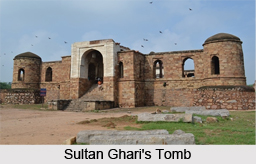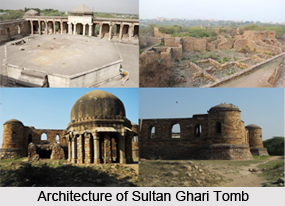 Sultan Ghari Tomb was the oldest Islamic mausoleum which was established during 1231 AD for Prince Nasiru`d-Din-Mahmud who was the eldest son of Iltutmish near Malakapur village in Delhi. Currently, this region corresponds to Vasant Kunj locality of the national capital of the country. Iltutmish belonged to the Slave Dynasty and he was its third Sultan who reigned Delhi from 1210 till 1236 AD. The region wherein the Sultan Ghari Tomb is existent was once a portion of the first Indian city of medieval Delhi and was a crucial place for the Slave Dynasty which remained in power from 1206 to 1290 and presently, it is within the Qutb complex. This tomb is based inside a `Ghari` or cave which can be accessed by a winding stone series which is supported by flooring and strong pillars. An octagonal terrace slab covers the cave. A combination of sandstone and marble embellishes the outer parts of the tomb structure which is equipped with towers or `bastions` on corners, which makes the Sultan Ghari tomb resemble a beautiful fortress following the oriental and Persian style of architecture. The other tombs which are present in the premises of Sultan Ghari tomb are yet to be identified.
Sultan Ghari Tomb was the oldest Islamic mausoleum which was established during 1231 AD for Prince Nasiru`d-Din-Mahmud who was the eldest son of Iltutmish near Malakapur village in Delhi. Currently, this region corresponds to Vasant Kunj locality of the national capital of the country. Iltutmish belonged to the Slave Dynasty and he was its third Sultan who reigned Delhi from 1210 till 1236 AD. The region wherein the Sultan Ghari Tomb is existent was once a portion of the first Indian city of medieval Delhi and was a crucial place for the Slave Dynasty which remained in power from 1206 to 1290 and presently, it is within the Qutb complex. This tomb is based inside a `Ghari` or cave which can be accessed by a winding stone series which is supported by flooring and strong pillars. An octagonal terrace slab covers the cave. A combination of sandstone and marble embellishes the outer parts of the tomb structure which is equipped with towers or `bastions` on corners, which makes the Sultan Ghari tomb resemble a beautiful fortress following the oriental and Persian style of architecture. The other tombs which are present in the premises of Sultan Ghari tomb are yet to be identified.
History of Sultan Ghari Tomb
Iltutmish had conquered eastern India during 1225 AD and invaded Lakhnauti, which constitutes the present-day Gaur in West Bengal and this war ensured the signing of a treaty between Iltutmish and Izaz, the then ruler of eastern India comprising Bengal and Bihar. Izaz agreed to pay a sum of 80 lakh `tankas` which meant silver currency, besides 28 elephants and the issuing of coins in the name of Iltutmish and accepting Sultan`s control over the area. Iltutmish divided the area into Lakhnauti and Bihar prior to his return to his capital in Delhi. Iltutmish had established Alauddin Masud Jani as the governing authority in Lakhnauti but he was soon ousted by Iwaz.
The Iltutmish installed Prince Nasiru`d-Din Mahmud to fight against the king Iwaz and consequently Iwaz was killed during 1227 AD, along with his noblemen. Prince Nasiru`d-Din Mahmud who was then proclaimed the governor of Lakhnauti, joined Bihar, Bengal with Awadh and made Lakhnauti his official capital. Iltutmish was very pleased with the Prince and hence bestowed upon him the prestigious title of `Malik-us-Sharq` or `king of the east`. However, after a brief period of 18 months, Prince Nasiru`d-Din-Mahmud was assassinated, which was a major blow to Iltutmish, as he was the eldest son of this ruler. Therefore, a tomb was built by Iltutmish in the honour of the deceased.
Iltutmish died in 1236 and his tomb was placed near Qutb complex. Two of his other sons named Muizzudin Bahram Shah who was killed 1241 AD and Ruknuddin Feroze Shah who died during in 1237 AD were all buried in different cenotaphs or `Chhatris` close to Sultan Ghari Tomb. The tomb of Razia Sultan, their renowned sister was also buried here. While two of the Chhatris have been renovated, one of the Chhatris are yet to be restored. Certain archaeological findings conducted at Sultan Ghari Tomb have revealed a stone lingam, scattered ruins of the Mughal age, a deserted mosque of Sultan Firoz Shah Tughlaq and an inscription of 1361 which recorded the excavation of a tank for marriage.
Architecture of Sultan Ghari Tomb
The architectural design of Sultan Ghari is quite unique as it has been constructed in the manner of a fortress which is armed with a courtyard-like area which is very rare among tomb structures. It is based over a raised platform built of rubble masonry work. The tomb is octagonal in shape and it possesses four cornet towers erected over a cave in front of the Qibla wall which is present on the western part of the mosque. Thus the Sultan Ghari Tomb comprises a double structure of an underground room for the crypt and a tomb which exists over the ground.
The grave is octagonal and its underground chambers are held together by four columns supported on two pillars and portray olden relics of Indian temples, particularly on the floor and the walls. Lime and concrete have been employed to create the terrace of the grave chamber. Beautiful Afghan and Turkish patterns adorn the marble `mihrab` of the western prayer hall or the `qibla`. Quranic inscriptions are existent on the surface of the marble mihrab. The anterior elevation of the western prayer hall possesses a marble fa‡ade belonging to the regime of Firoz Shah Tughlaq. Visitors will notice a `yoni-patta` or the base of Shiva Lingam near the front part of the qibla.
Corbel arch construction pattern is witnessed in the tomb structure which was often utilized in several Islamic buildings in India, prior to its utilization by the Romans. It is said that Firoz Shah Tughlaq who had ruled from 1351 till 1388 AD had introduced some repairs to this tomb, which was severely damaged. Close to Sultan Ghari is present a Chatri which is the tomb of one of the sons of emperor Iltutmish of Slave Dynasty and it was also preserved during the reign of Firoz Shah. The tomb is flanked by ancient ruins of villages. Towards the southern portion of Sultan Ghari is located the remnants of an old Tughlaq mosque, a `khanqah` and Jami Masjid.
Worship at Sultan Ghari Tomb
Sultan Ghari is an important pilgrimage spot for Muslims as well as Hindus and devotees from Rangpuri and Mahipalpur villages regularly visit this place as they believe it is the holy abode or `dargah` or a `peer` or saint. Newly wedded people visit the tomb for obtaining his divine blessings and it is much better conserved by the regional inhabitants than the Archaeological Survey of India or ASI. During Thursdays, Muslims and Hindus arrive at Sultan Ghari. The tomb is thronged by innumerable pilgrims from various portions of Delhi during the 17th day of the Islamic month of `Ziqad` and even during `Urs`, which means the death anniversary of Nasiruddin Shah.




